Please Note- this website is best viewed on a desktop/laptop as it is not mobile-friendly. I am working on trying to convert it!
The Orientalist art movement saw many western artists who travelled through the Near and Middle East from the start of the nineteenth century, painting their experiences as they traversed countries such as Turkey, Persia, Iraq, Egypt, Lebanon and Palestine.
Many of Joseph Austin Benwell's larger artworks (watercolour/gouache) were of the Orientalist style and date from the later part of his life. It is known that he was travelling in the Near and Middle East around the mid 1860s, in particular Egypt and Palestine from 1865-66. Most of his paintings in this genre were painted from around 1865 up until close to his death in 1886. His subjects were principally Egyptian, Syrian and Arabian, he specialised in Bedouins and their camps and caravans traversing the desert with camels, often with ancient ruins in the background. He often featured the iconic 'white camel' in his paintings.
It was during this period that he exhibited most widely, at institutions including The Royal Academy, The Royal Institute of Painters in Water Colour, Suffolk Street in London, The Royal Society of Artists at Birmingham, The Walker Art Gallery at Liverpool, Manchester City Art Gallery, The Royal Hibernian Academy and The Royal Society of British Artists. He also exhibited at the London International Exhibitions of 1871, 1873 and 1874, (London International Exhibition of 1873), the Sydney International Exhibition of 1879-80 and the Melbourne International Exhibition (1880-81). A review for the Sydney International Exhibition (10 February 1880) states “’Desert Travelling, Valley of Sinai’ by J A Benwell, a fine sunset effect. A couple of camels labor along in the foreground with that peculiar look of patient endurance with which they are credited, but which is more apparent than real. The color is telling, but subdued.”
Joseph Austin Benwell may not be one of the best known Orientalist artists, although he is referred to in various publications such as 'Les Orientalistes de l' Ecole Britannique' by G M Ackerman, Paris 1991, and 'Les Orientalistes Peintres Voyageurs' by L Thornton, 1983. His paintings command quite high prices at international auction houses today. Some examples of his paintings are shown below.
It seems to be fashionable in these politically correct times, particularly since the publication of Edward Said’s 'Orientalism' (1978), for some to think of orientalist art in somewhat negative and critical terms. Said considered that prejudiced outsider-interpretations of the Eastern world were shaped by the cultural attitudes of European imperialism in the 18th and 19th centuries. Said was of the opinion that Orientalism created patronising and possibly demeaning views of the non-Western world. It is true that some Orientalist artists may have painted what could be considered as somewhat risqué or condescending scenes. But Benwell, like most other Orientalist artists, was most definitely a realist, working with dedication and enthusiasm to accurately depict what he saw on his travels in the Orient. Working within the social and political conditions prevalent at the time, such artists have provided us with a valuable ‘snapshot’ and record of life in these countries during a bygone age.
To quote the artist John Singer Sargent: "I do not judge, I only chronicle."
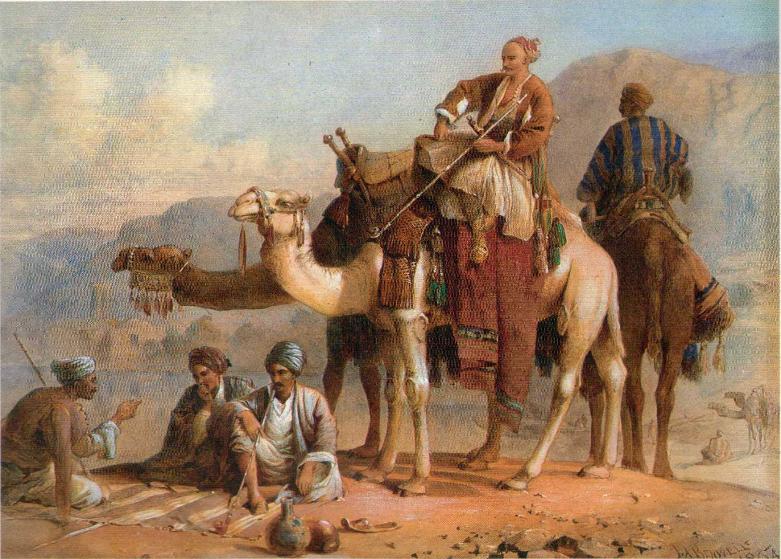
'The Meeting Place', signed and dated 1864.
This watercolour must be one of Benwell's earliest painted Middle-Eastern scenes. At the time, he was still producing wood engravings and black and white illustrations for publications such as The Illustrated London News, and Religious Tract Society journals and books.
'The Arab's Bride'1875
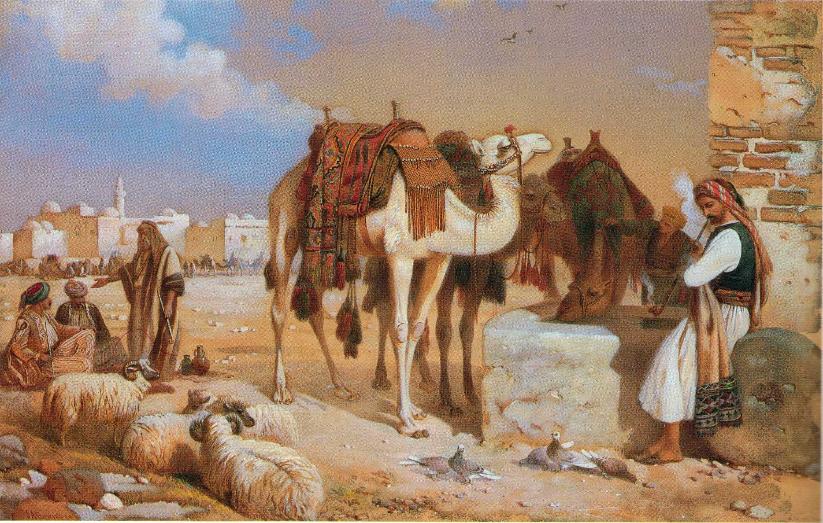
'At the Well' 1871
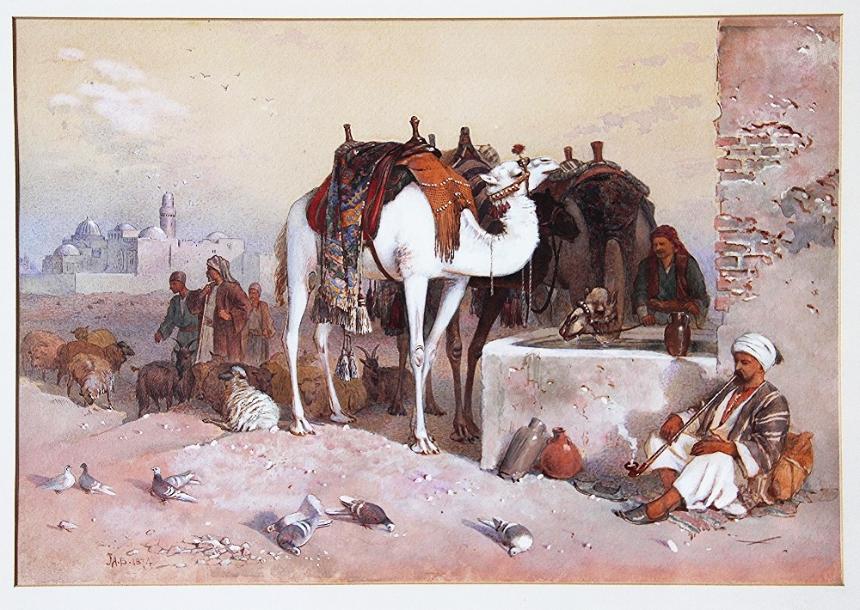
'At the Well' 1874 (v. 2), or - 'Three camels at a water trough with figures, sheep and goats and a temple in the distance'
Above is shown 'At the Well' 1874, another version, or - 'Three camels at a water trough with figures, sheep and goats and a temple in the distance'. Initialled JAB 1874 lower left.
Note similarities with the 1871 painting above, and how this painting is a 'variation on a theme' thereof. Benwell would have made sketches on his travels, often completing the actual paintings back in his studio in Kensington. Sometimes he varied the figures and details in each painting, whilst keeping the original composition and overall theme. Another example is shown further down the page - variations of 'An Arab caravan in the Sinai Desert', 'Head of the caravan, Mount Sinai', 'Caravan of camels crossing the desert, mountains beyond' and others are all quite similar but vary in small but distinctive details.
Another painting, 'Fountain at Old Gaza (Palestine)' (1873), below right, depicts an old well very similar in structure to the wells shown in the two paintings above. Note the pigeons in the foreground of all three paintings, and other similarities. Although a location is not given for the first two, maybe they depict scenes in Old Gaza too. A painting also entitled 'A Fountain at Old Gaza, Palestine' was exhibited in 1867, this is referred to on page 39 in 'Works Exhibited at the Royal Society of British Artists, 1824-1893 and the New English Art Club 1888-1917' (An Antique Collectors' Club Research Project) by Jane Johnson c1982. This is likely to be an earlier version of the 1873 painting though, as it was exhibited in 1867.
Another of Benwell's paintings was also called 'At the Well' but undated (see below, left). This signed watercolour heightened with white, 153/4x203/4in (395x520mm) was sold by Christie's on 24 November 1983.

'At the Well'
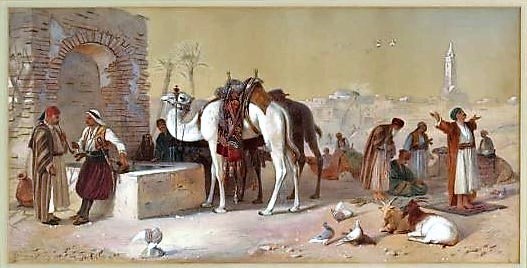
'Fountain at Old Gaza (Palestine)', 1873
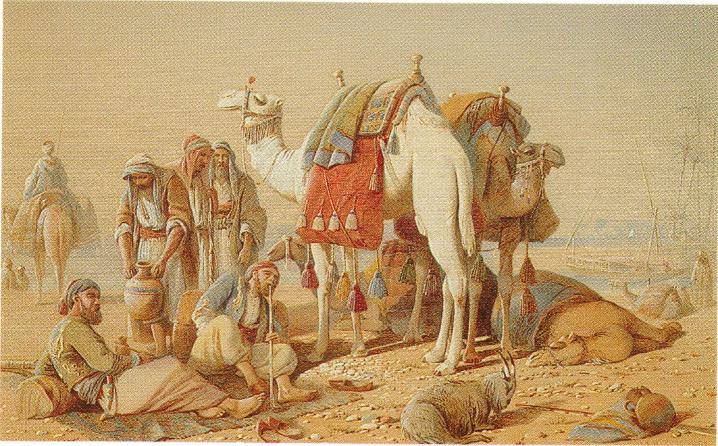
'An Arab caravan resting by the sea' 1865
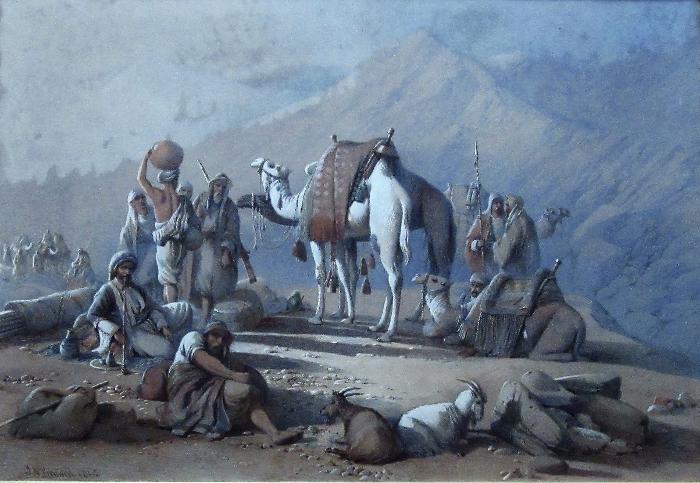
'Caravan at Rest' 1865
The two paintings above are both amongst Benwell's earliest (1865), and show some similarities in subject and composition. The top one shows figures by the sea in a flat landscape, whereas the lower depicts a mountainous landscape with a camel caravan approaching from the distance (left). The shadows are long, so it is likely to be an early evening scene after a long day travelling. Benwell was an engraver and illustrator for many years before he turned to painting, and the figures reflect this.
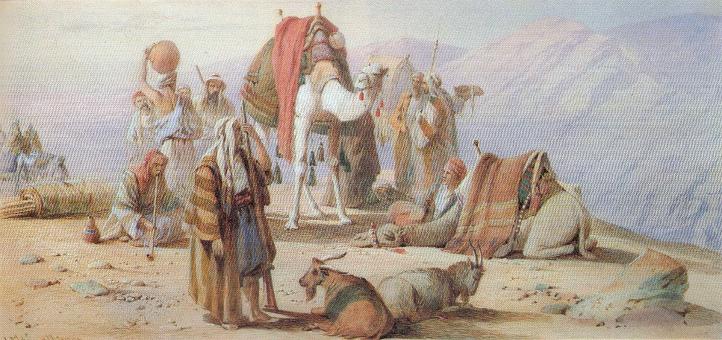
'A Halt in the Desert' 1865
Watercolour depicting Arab warriors on camel back (no title), undated
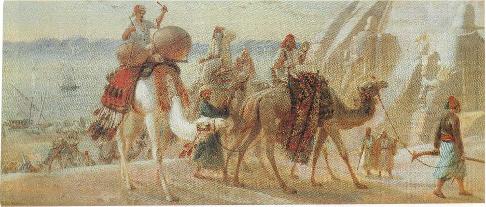
'An Arab Caravan by ruins near the Nile'
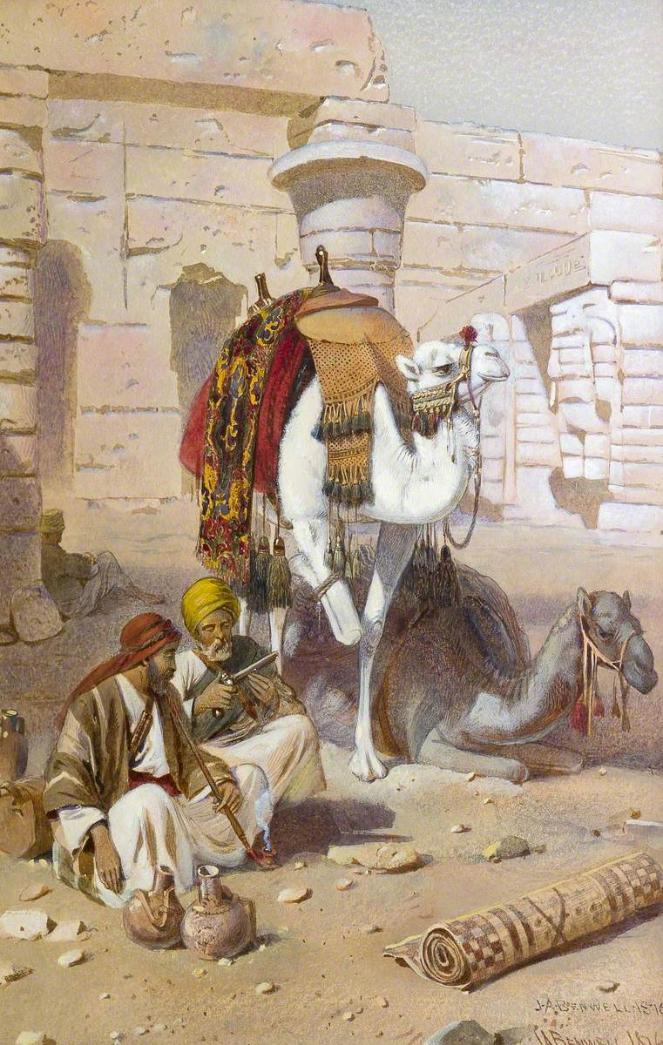
'A Rock Temple in Nubia' 1876
Now held at Russell-Cotes Art Gallery & Museum, Bournemouth. From Art UK website.
Lot 111: A Rock Temple in Nubia, signed and dated twice 'J A Benwell 1876'; pencil and watercolour heightened with bodycolour 12 5/8 x 8 5/8 in. (322 x 220 mm.) Christie’s. London, 11 July 1995. From the similarity in shape of the buildings, and the fact that the temple is in Nubia, it is possible that this painting depicts the Temple of Maharraqa (dedicated to Serapis), Nubia, as does the painting shown below (‘In Nubia, Arabs on camels before the ruins of a Temple’).
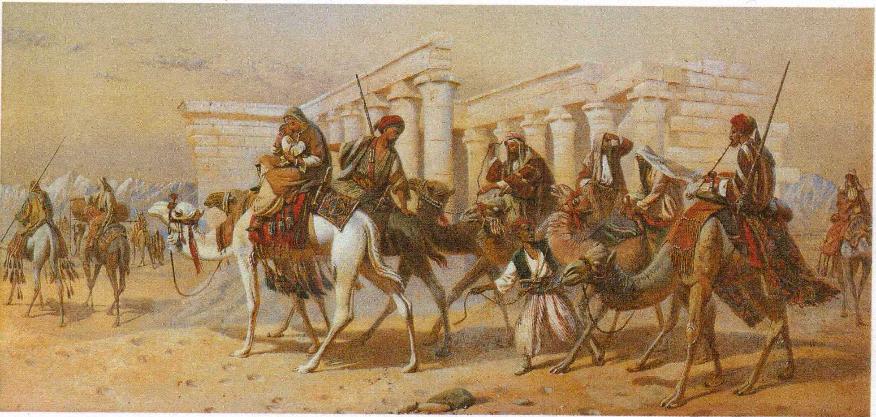
'In Nubia: Arabs on camels before the ruins of a Temple' 1870
'The buildings depicted in the background are almost certainly the Temple of Maharraqa (dedicated to Serapis, early images shown below), in the ancient Egyptian region of Maharaka (or Maharraqa), Lower Nubia. The temple was dismantled in 1961 and rebuilt 4 km away as it was threatened by flooding from the Nile by the Aswan Dam construction project.
It could possibly be the painting referred to in the Birmingham Daily Post, 21 May 1881, exhibited at the Birmingham Royal Society of Artists Spring Exhibition 1881- J A Benwell ‘Mecca Pilgrims passing Maharaka, Nubia’ (refer to the section on Provenance, Section 1 Old Newspapers (below).
The painting has been known as ‘In Nubia, Arabs on camels before the ruins of a Temple’(sold for £4,536, Christie's 26 February 1985), and also ‘A Caravan of camels by ruins in the Desert’(sale Sotheby's 17 October 2001).
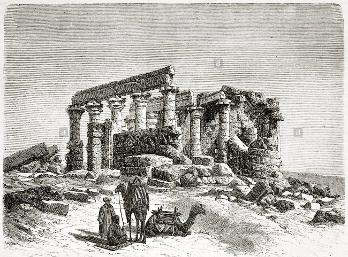
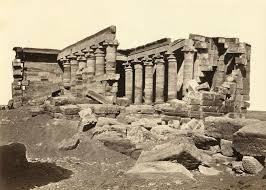
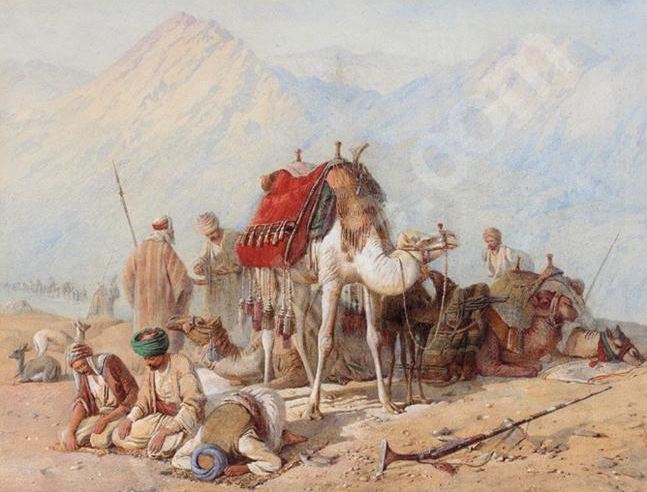
'Arabs Praying in the Desert ' with a Caravan of Camels beyond'
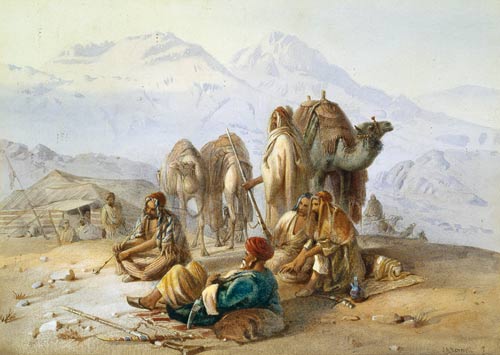
'An Arab Encampment'
'A Rest Before the City Gates' (below)
There is no signature clearly visible on the left hand side image (sold 2008), but this is because it is now mostly hidden under the mount. The date 1880 appears faintly. The signature and date are lower left, below the clump of grass. The painting was sold unframed in the 1984 sale, and a new frame and mount must have been added around that date. The 1983 sale states 'signed and dated 1882' and the 1984 sale states that the painting was dated 1880. In fact, the last digit is not very clear, but on the latest image it looks to be 1880. An enlargement of the black and white photo in the 1983 catalogue is shown below. Note the actual image size in this description (1983) is slightly larger than given in the 2008 description, indicating that the new 1980s mount covers some of the image.
The 'City' in the title could be Cairo, Luxor, Jerusalem, or possibly Jaffa (now part of Tel Aviv). The tower, when zoomed-in on, looks to be six-sided, and there are domed buildings to the right. There is a similarity to the minaret of the Mahmoudiya Mosque at Jaffa, in terms of shape and configuration of the adjoining domed buildings, near the old Jerusalem gate (Abu Nabbut Gate) and the old city walls. Most of the current mosque was built in 1812 by Muhammad Abu-Nabbut, the Governor of Gaza and Jaffa. The rebuilding of the city wall fortifications was completed under Abu-Nabbut from 1810 and onwards. He added a monumental eastern gate crowned with three cupolas. The painting depicts several cupolas or domed-roof buildings with a wall in front. The tower on the painting may have some degree of artistic license, as it appears chunkier than it does in real life. The railings may have been added after the original sketch for this painting was made (probably mid-1860s). Note the Tower of David is circular in girth, not hexagonal as this tower appears to be.
The buildings also could be seen as being similar to those in the painting below ' 'The Desert Caravan, Egypt' 1874, or ' A Camel Train leaving Luxor' and 'Travellers at Luxor', 1877. So the location could be Luxor, as well as Cairo.
If anyone has any other ideas where this scene could be located, please let me know!
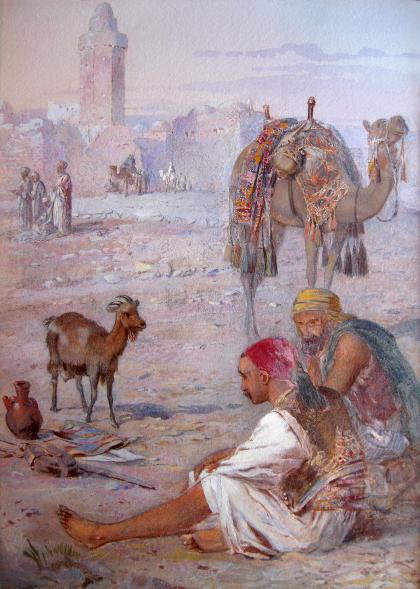
'A Rest before the City Gates' sold Christie's 1 October 2008.
Image size: 13 3/8 x 9 ½ ins.
Previous title 'Arabs resting outside a town' (Lot 173 Christie's sale 29 Nov 1984 and Lot 134, 13 Dec 1983), and 'Arabs resting on the outskirts of a City' (Lot 451, Sotheby's sale 6 Nov 1985).

Arabs resting outside a Town' signed and dated 1882
Image size 13 ¾ x 9 7/8 ins.

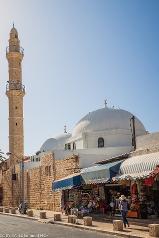
Mahmoudiya Mosque, Jaffa
By Edmund Gall (2014-06 Israel - Tel Aviv 11) [CC BY-SA 2.0 (https://creativecommons.org/licenses/by-sa/2.0)], via Wikimedia Commons)
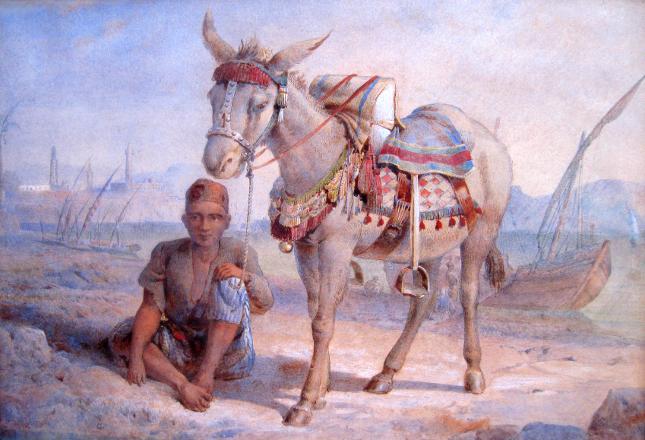
'Egyptian Muleteer' (or, 'The Muleteer')
Previous title 'The Egyptian Muleteer' (Lot 406, Sotheby's sale 6 Nov 1985), and likely 'Egyptian Mule Boy' (Lot 122, Phillips sale, Chester, 15 Feb 1985)
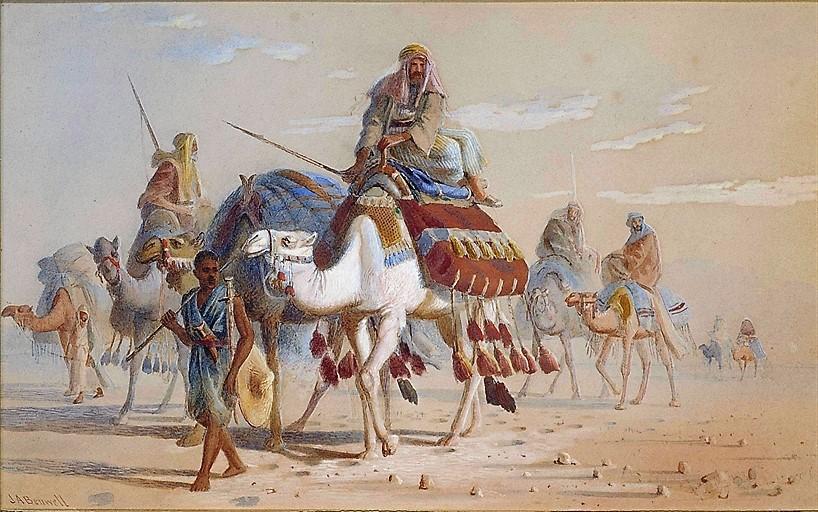
'Crossing the Desert '
The location of this scene is likely to be Upper Egypt or Nubia, given the ethnicity of the man leading the camel. Benwell spent some time in Nubia, and produced several paintings featuring this ancient region (Southern Egypt, also northern Sudan).
'Travellers at Luxor', 1877
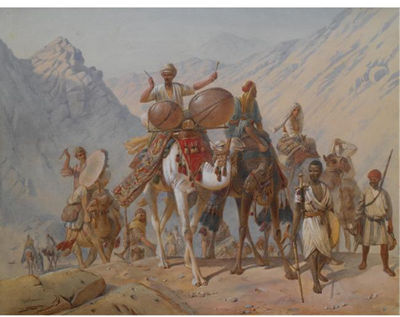
'The Caravan'
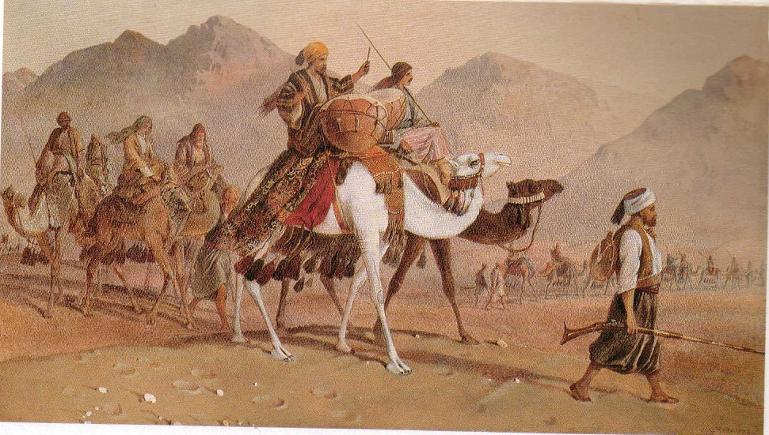
'The Head of the Caravan passing Mount Sinai' 1877
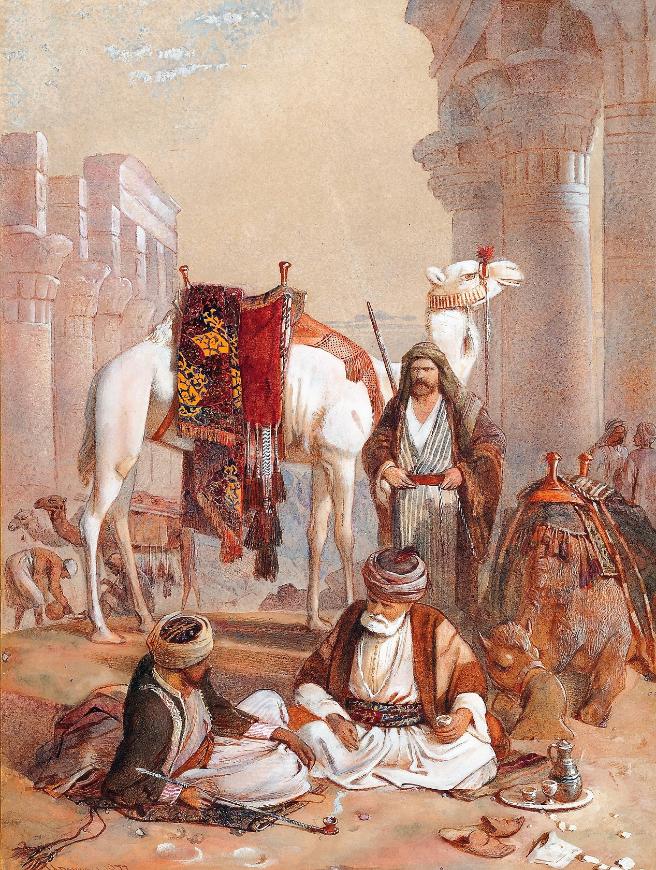
'The Temple of Isis, Philae' 1877
or, 'Arabs drinking coffee and smoking at the Temple of Isis, Philae'
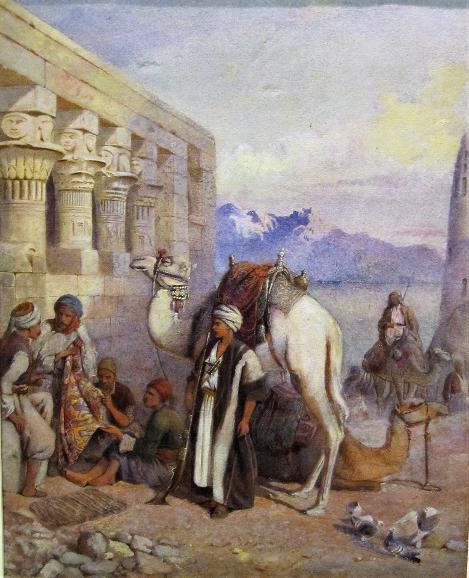
'Carpet dealers at Philae' 1885 (Victoria & Albert Museum)
After William James Müller 'A group of Arabs at prayer, with distant camels' (or 'Middle Eastern landscape with figures at prayer')
For more information on this mystery, see 'Benwell, William James Müller and ‘Prayers in the Desert’
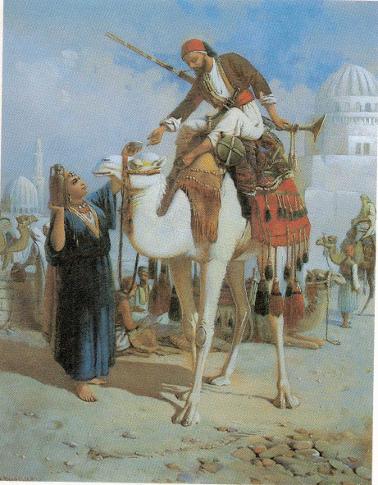
'A Soldier's Refreshment' 1870
Paintings depicting Camel howdahs or hawdaj
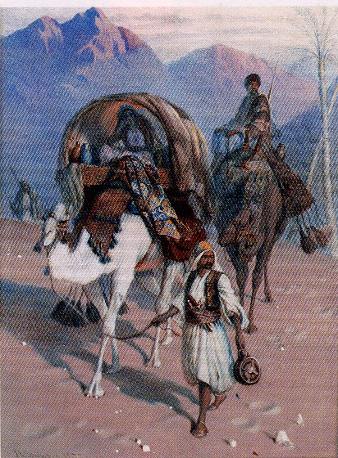
An Arab Caravan' 1877
Paintings depicting howdahs (or hawdaj, Arabic)
Note the similarity in subject and style of these paintings (and others on this page), depicting tent-like structures (hawdaj) or palanquins on the backs of camels, usually used for carrying women. In particular the two above ('An Arab Caravan' and 'In the Desert, Sinai', 1877), left and right, vary only in very minor details. Why did he sign one lower left, and the other lower right? 'Sunset in the Valley of Sinai' (right) is another very similar in composition.
'Similarly, the 'Caravan of Camels crossing the desert, mountains beyond' 1881 looks very similar to 'Head of the Caravan, Mount Sinai' 1882 and 'A Musical Caravan' at first glance, but the figures, camel bridle and foreground details vary slightly.
Benwell specialised in drawing and painting groups of figures, and this particular subject appears to have been one of his favourites. Some of these scenes depicting hawdaj are likely to be Arabian bridal processions – as part of wedding festivities women would be ceremoniously transported to their new home in a hawdaj mounted on a camel’s back. Another example is 'An Arabian beauty with camel and caravan procession' (in the 'Changing Titles' section below.)
As was the case with other Orientalist artists, it is likely that he made sketches during his travels to the region in the mid-1860s (and possibly later), and completed paintings based on his sketches back at his studio in Kensington, London.
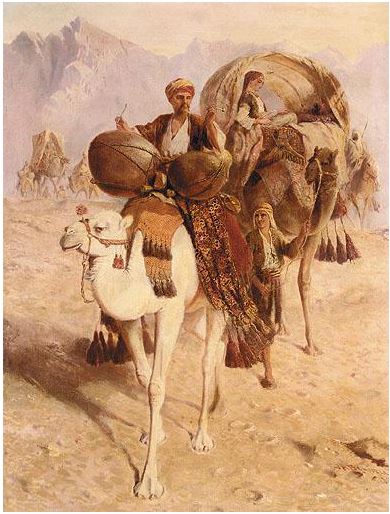
'Caravan of camels crossing the desert, mountains beyond' 1881
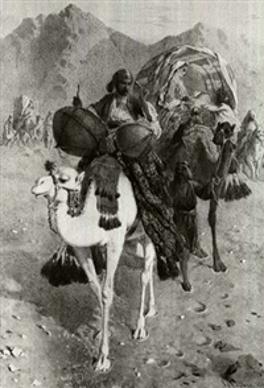
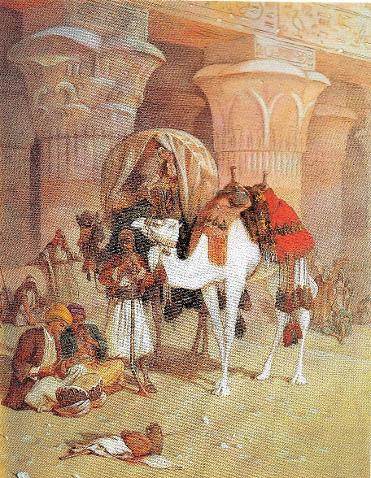
'A musical caravan'
Kom Ombo, Upper Egypt' 1876
The painting on the right (37 x 25cm) shows a large open-ended howdah with two seated women on the back of the camel. One of the women is cradling a baby. It features one of Benwell's iconic white camels. It is unusual as it also shows a young white camel, reflecting a theme of mother and baby. The mountainous scenery suggests the location could be in the region of Mount Sinai, Egypt, where Benwell set many of his paintings. Benwell generally always preferred to feature groups of figures in his paintings rather than landscapes, going back to the late 1840s/1850s when he specialised in woodcut engravings also featuring figures, mainly from India. It was sold at auction in April 2021.
'In the Desert, Sinai' 1877, or 'The Caravan' (signed lower right)

'Sunset in the Valley of Sinai' (signed and dated 187_, likely 1876.)
19 ¾ x 15 ½ ins. Sold in 1980 (Sotheby Parke-Bernet) and 1989 (Phillips).
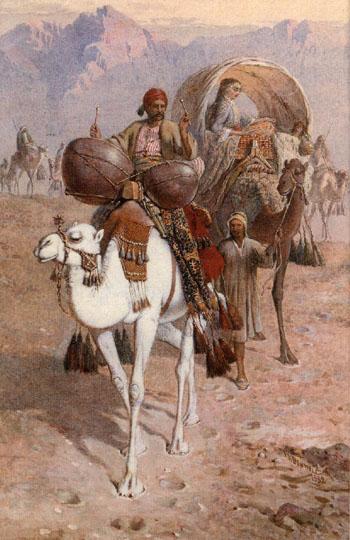
'Head of the caravan, Mount Sinai' 1882
'An Arab Caravan in the Sinai Desert'
Lot 223, Christie's 2 November 1979
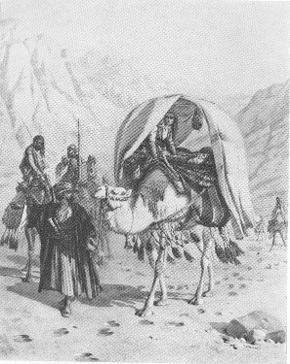
'Eastern Merchants' shows a hawdaj with the fabric folded off the frame. This painting is very likely to be set in the Temple of Kom Ombo, Upper Egypt, as it is the same building as that on the left.
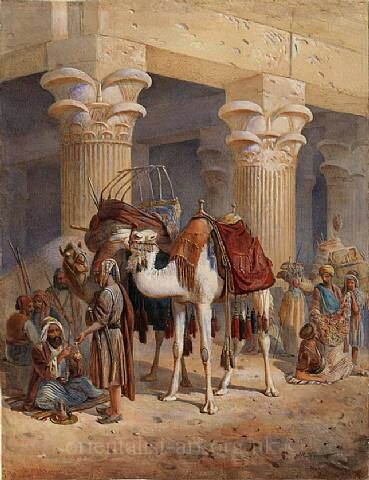
'Eastern Merchants'
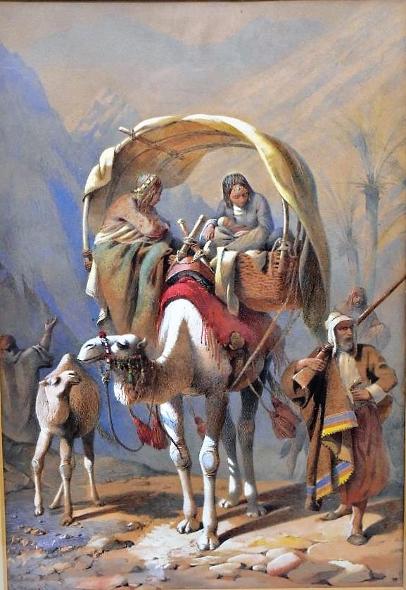
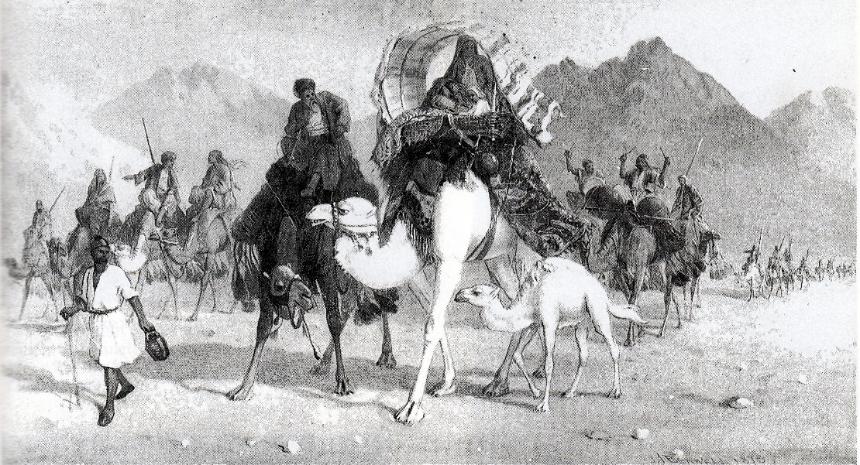
'An Arab Caravan' 1873
This painting, 'An Arab Caravan' dated 1873 (signed and dated lower right), was sold by Bonhams of London and appeared in 'Miller's Picture Price Guide' 1993. It features a woman with a small child in a howdah on a white camel, and a young white camel beside, reflecting a mother and child theme. Notice the similarities in composition with 'The Arab's Bride' (1875), below, in particular the stance of the brown camel to the left, almost identical in both paintings. Both include musicians with drums in the near background. The figures and grouping of camels vary, but both have an older man on a camel escorting the white camel, and a man on foot apparently leading the way. Benwell would probably have worked up the sketches he made whilst on his travels, and later used them as the basis for his watercolour paintings in his studio.
'The Arab's Bride' 1875
Arab weddings have changed considerably over the past 100 years or so. At the time Benwell was travelling and making sketches and paintings in the 1860s and 1870s the traditional Arabic marriage, with a procession as shown, was more like a Bedouin wedding. Weddings often included a ‘Zaffa’ or procession that loudly announces the couple’s wedding.
The painting (70cm x 35cm, 27.5ins x 13.75ins) shows a camel with two mounted drums and a drummer also in the procession, This may have been typical of weddings in the 19th and early 20th century and is shown in other images, for example ‘Wedding Procession near Siut’ by A Schonn, engraving from a drawing by Louis Libay for a Voyage to the East, 1857, Egypt. Similar drummers on camels are also shown in early photographs of Arabian weddings, for example ‘Arab Marriage’ (Mariage Arabe) by Zangaki (photographer), Palestine and Egypt 1894. Also ‘Arab Wedding- Drummers mounted on Camels’ Syria c 1900. The man leading the procession is carrying a rifle, which may possibly be used for the tradition of celebratory gunfire at a wedding.
Below is shown 'Mariage Arabe', 1894 by Zangkaki, a photograph showing drummers on camels at a wedding, similar to the drummer in the procession in Benwell's painting.
Source: The Miriam and Ira D. Wallach Division of Art, Prints and Photographs: Photography Collection, The New York Public Library. (1894).
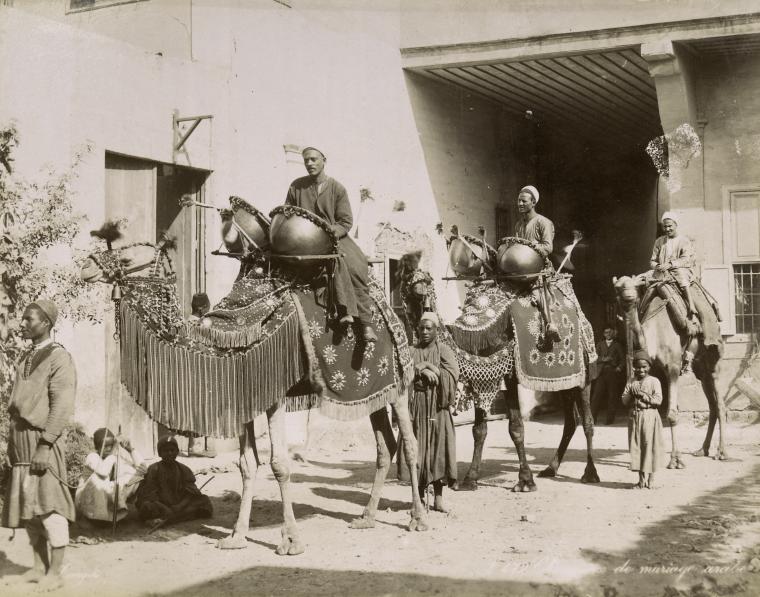
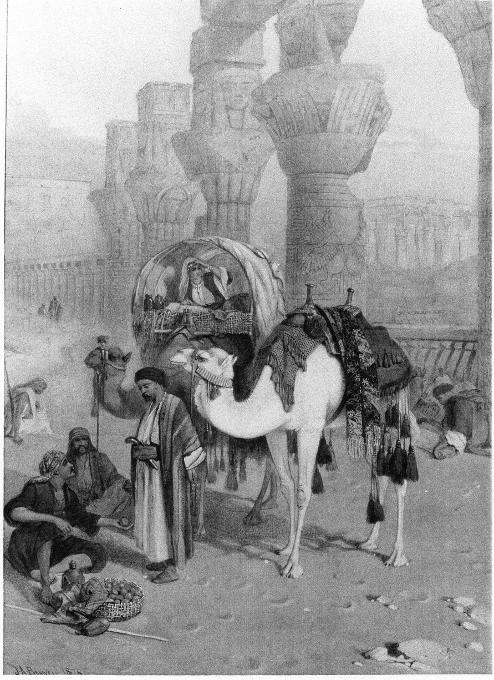
'The Caravan' 1878
,
More hawdaj (hawadij plural) or howdahs. Above ('The Caravan' 1878, Lot 18, Christie's 3 November 1977) the camels are in a similar position/grouping to those in 'Kom Ombo' and 'Eastern Merchants', above. This painting, together with Lot 11 'The Head of the Caravan' 1880, was one of 123 Orientalist lots sold at this 1977 sale belonging to a collector and acquired mostly during the 1950s. They reflect the previous owner's lifelong interest as a traveller and writer in the Middle East.
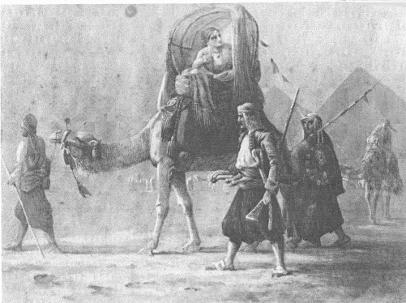
'Caravan passing by the Great Pyramids'

‘An Arab Caravan outside a Town’ 1871

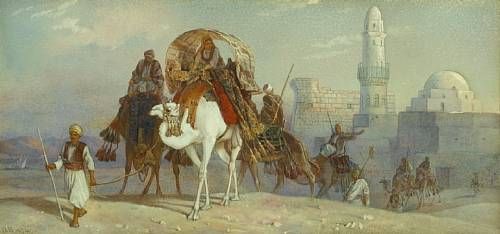
'The Desert Caravan, Egypt' 1874, or ' A Camel Train leaving Luxor'
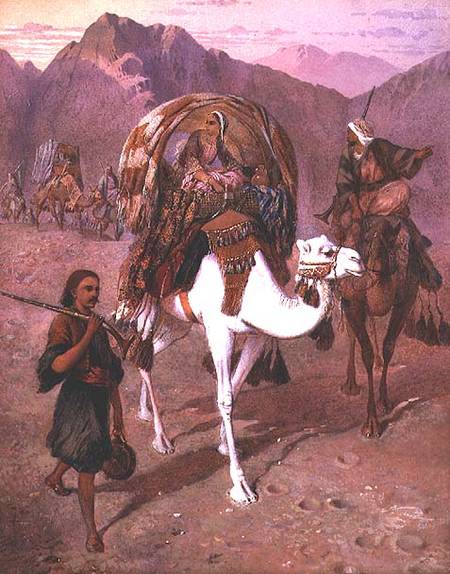
'The Queen of the Caravan' 1881

'A Caravan passing the Statues of Memnon in the Plain of Goorna at Thebes' 1876
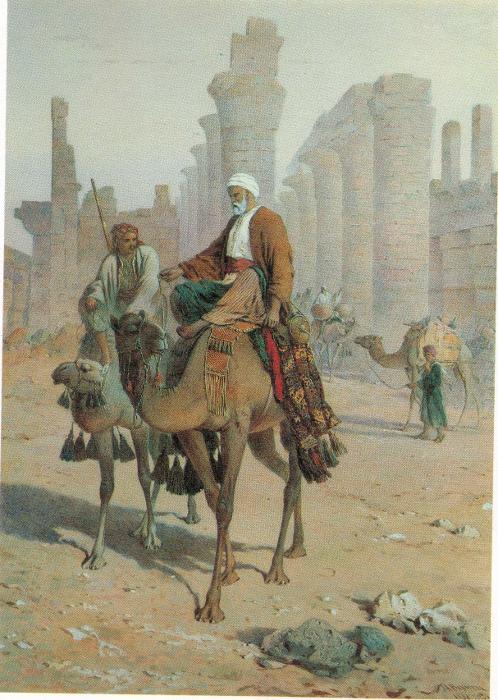
'A caravan by an Egyptian Temple' 1881
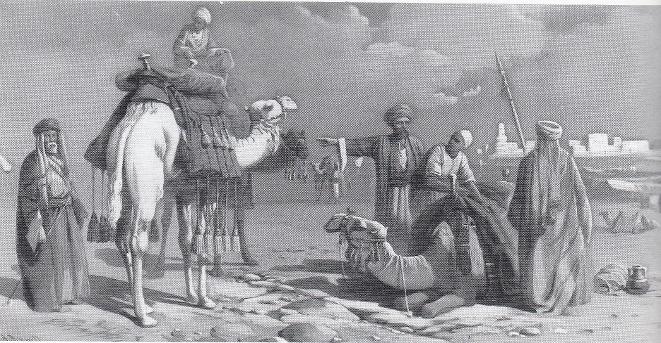
'A caravan on the shore'
(8.38 x17ins), Lot 193, Christie's 28 April 1987
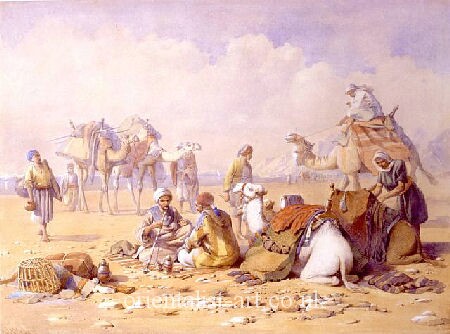
'Halt by the Red Sea', or 'A resting caravan sharing a pipe by the water's edge'
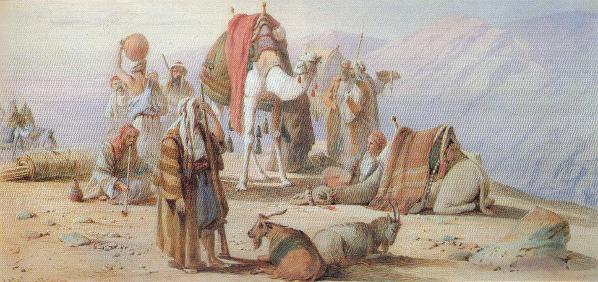
'A halt in the desert' 1865
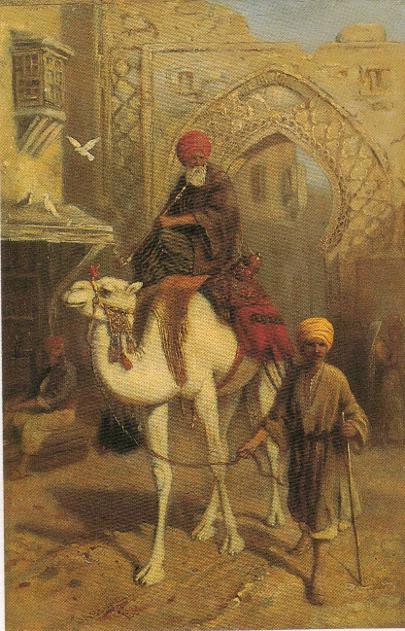
'An Arab on a camel in a near-Eastern town' 1881
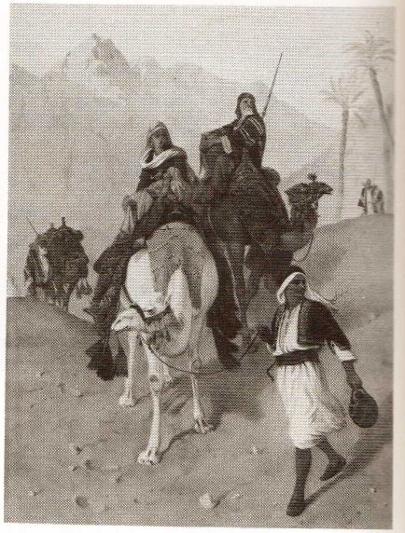
'A Caravan in the Desert’ 1873.
19.5 x 14.25 in (49.5 x 36 cm),
Lot 138 Sotheby Parke Bernet, London 16 October 1981
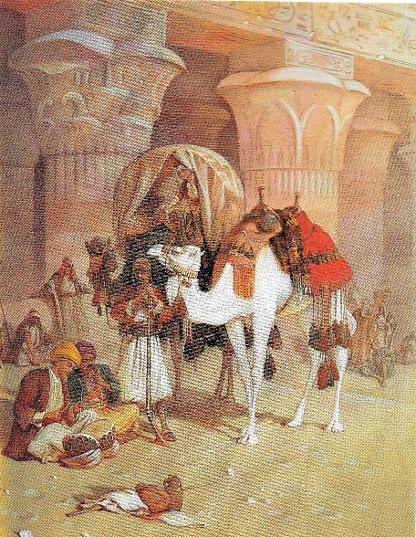
'Kom Ombo, Upper Egypt' 1876
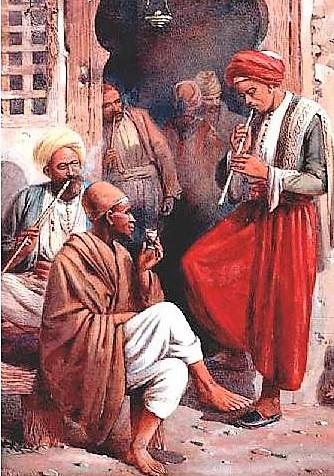
'Outside the cafe' 1867
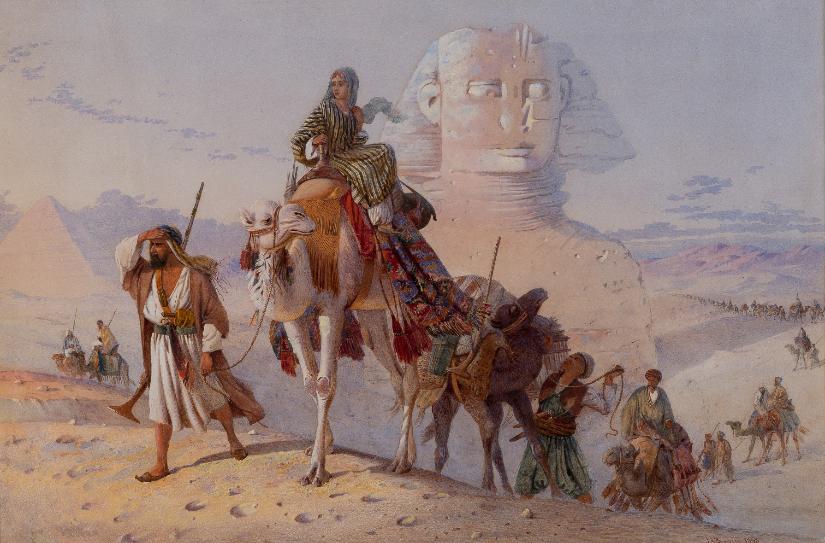
'A Caravan with the Pyramids and Sphinx Beyond' 1868

'Outside the Temple of Dendera' 1877
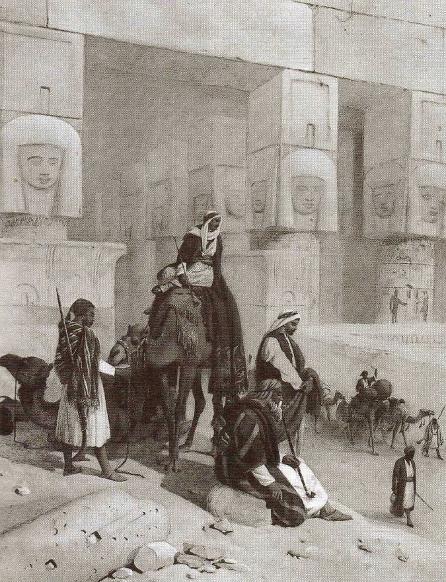
'The Temple of Dendera, Thebes' 1871
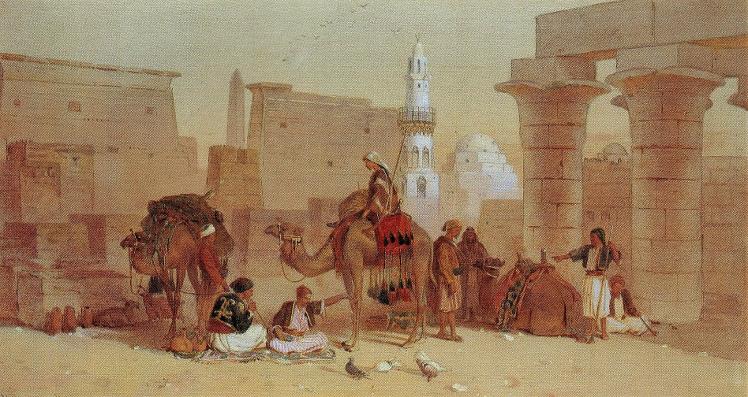
'Arab Traders feeding pigeons near a Mosque' 1874
The painting above shows a scene at Luxor Temple. The mosque in the painting is the Mosque of Abu Hagga, which was originally built on the ruins of Luxor Temple. The viewpoint of the background is more or less the same as in 'Travellers at Luxor' 1877 and 'Resting among Egyptian ruins at evening' 1875.
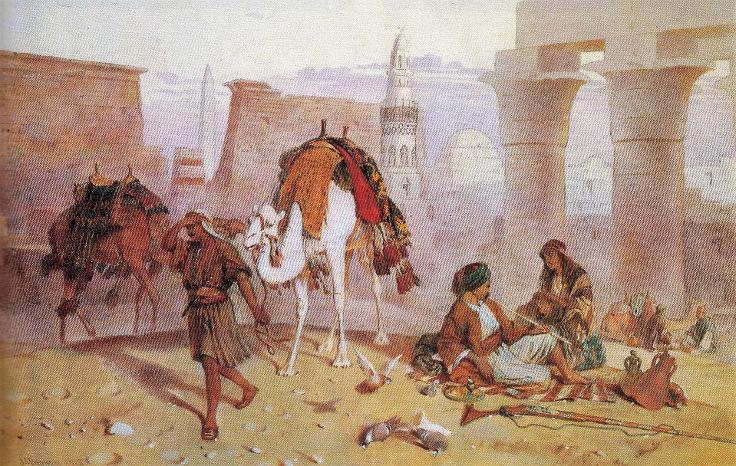
'Resting among Egyptian ruins at evening' 1875
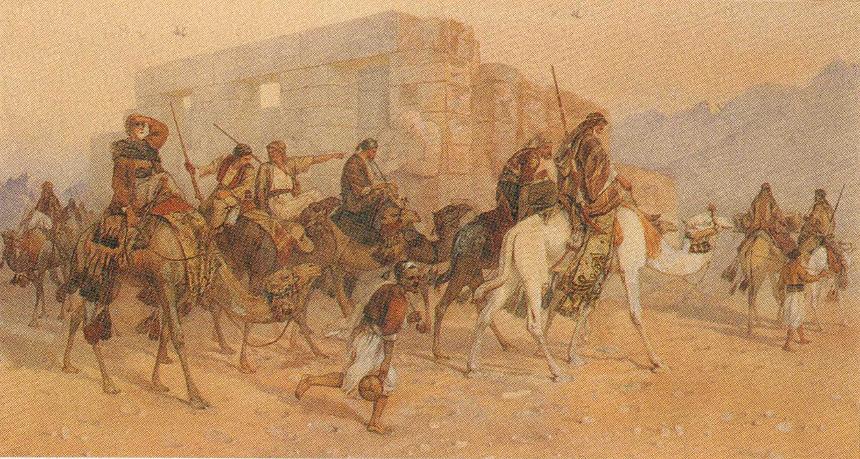
'The Expedition'
Provenance - the clues are there!
1. Old newspapers
Old newspapers can be a useful source of information about paintings, particularly Victorian paintings. You may be able to find out where and when your old picture was exhibited or sold.
A good website to use is The British Newspaper Archive. Searching for the name of the artist may result in articles or advertisements being found - including art exhibitions, art sales and auctions. As well as listings, you may find descriptions of the artwork, which can further aid provenance research.
Listed below are some examples of works by Joseph Austin Benwell that are recorded in various newspaper archives, in descriptions of exhibitions and sales during the second half of the 19th century. This can be a good way to add to the provenance of old artworks, and can provide other clues about a painting’s history.
The Era, 9 November 1862, lecture and exhibition- ‘a set of dissolving views, painted by J A Benwell Esq., from sketches made during a long residence in the cotton-growing districts of India'
Western Daily Press, 21 April 1865, Exhibition at the Bristol Fine Arts Academy- J A Benwell ‘Under Mount Sinai’ - a drawing of camels. Also ‘On the Banks of the Nile, Egypt’
Salisbury & Winchester Journal, 6 June 1866, The Fine Art Exhibition- J A Benwell ‘Travelling in the East Valley of Sinai’
Western Daily Press. 11 June 1866, The Exhibition of the Works of Modern Artists- J A Benwell ‘Mohammedan Pilgrims Sighting Mecca’ ‘A most elaborate bit of work. The camels are executed with the utmost care, and the details of the picture are most cleverly worked in. It presents all the characteristics of a sketch of Oriental life, and is most exquisitely toned.’
Norfolk News, 10 August 1868, the Norwich Fine Art Association- J A Benwell ‘The Welcome Draught’ and ‘En Route to Egypt’ ‘Both are very atmospheric and transparent, and their effect is very pleasing’
Norfolk Chronicle, 12 September 1868, Fine Arts Exhibition- ‘some clever Eastern Scenes, in water-colours’ by J A Benwell.
The Glasgow Herald, 8 April 1869, Glasgow Institute of Fine Arts- J A Benwell ‘Ruined Mosque- Cairo’
The Glasgow Herald, 13 April 1869, The Fine Art Institute Exhibition- J A Benwell ‘Halt for Prayer under Mount Horeb’ (refer to picture below)
London Daily News, 26 April 1869, Fine Arts, The Society of British Artists, Suffolk Street Gallery- J A Benwell ‘Egypt- Pilgrims’
The Norfolk Chronicle & Norwich Gazette, 11 September 1869, Fine Arts Exhibition- J A Benwell ‘The First Halt from Jerusalem’
Western Daily Press, 6 April 1870- Fine Arts Exhibition- ‘Prayer at Old Gaza’ by J A Benwell ‘is a warmly-coloured drawing of an Oriental scene.’
The Examiner and London Review, 23 April 1870, Society of British Artists- J A Benwell ‘Travellers Resting’- ‘the vivid tints and deep shades are well disposed.’
The Graphic, 1 October 1870, Exhibition for the Relief of the Widows and Orphans of Germans killed in the War- J A Benwell ‘Street Scene in Cairo’
The Morning Post, 11 November 1875, The McLean Gallery, Haymarket- J A Benwell ‘The Colossi of the Plain, Thebes- approaching encampment’
Manchester Evening News, 17 September 1879, Atkinson Art Gallery Southport Spring Exhibition- J A Benwell- four studies of desert subjects.(including white camels)
Manchester Courier, 18 September 1879, Whaite’s Exhibition of Watercolour drawings- ‘The numerous Eastern scenes by J A Benwell give a vivid idea of Eastern modes of travel’
Liverpool Mercury,16 October 1879, Walker Art Gallery- J A Benwell ‘Travelling in the Desert (Sinai in the distance)’ ‘a very able drawing by this able painter of Eastern subjects’
Liverpool Mercury, 17 June 1871, Woolton Hall Sale- J A Benwell ‘Arabs Halting’
Birmingham Daily Post, 4 November 1884, Royal Society of Artists- J A Benwell ‘In the Desert, Sinai’
Yorkshire Gazette, 21 August 1880, The York Exhibition- J A Benwell ‘Inquiring the way in the Valley of Sinai’
Birmingham Daily Post, 21 May 1881, Birmingham Royal Society of Artists Spring Exhibition- J A Benwell ‘Mecca Pilgrims passing Maharaka, Nubia’
Bristol Mercury, 16 June 1881, The Fine Arts Exhibition- J A Benwell ‘Mount Sinai’ (sold)
Liverpool Mercury, 2 February 1884 - ‘The First Glimpse of Jerusalem’ by J A Benwell ‘reminds one of Carl Haag’
Liverpool Mercury, 26 April 1884, Atkinson Art Gallery, Southport Spring Exhibition - J A Benwell ‘Jerusalem from Bethany’
Liverpool Mercury, 16 May 1884, Hanover Galleries, important collection of pictures by order of the administrators of the late Peter Douglas Esq. - J A Benwell ‘Near the Walls of Jerusalem’
Bristol Mercury, 6 July 1887, Art Sale (Estate of the late Mr Henry Stevens)- J A Benwell ‘The Summit of Mount Zion, Jerusalem’
Liverpool Mercury, 7 October 1892, sale of choice watercolour drawings and oil paintings, valuable library etc., by order of Trustees in Bankruptcy Davies Bros and Co, Tea Merchants and Estate of John Davies- J A Benwell ‘Arabs in the Desert’
Liverpool Mercury, 28 October 1892, Hanover Galleries, by order of the administrators of the late Mr Joseph Aarons - J A Benwell ‘A Cairo Mule Driver’ (note, this could possibly be The Egyptian Muleteer, shown above)
Extract from 'Liverpool Mercury' 26 April 1884, Art Notes - 'Jerusalem from Bethany'
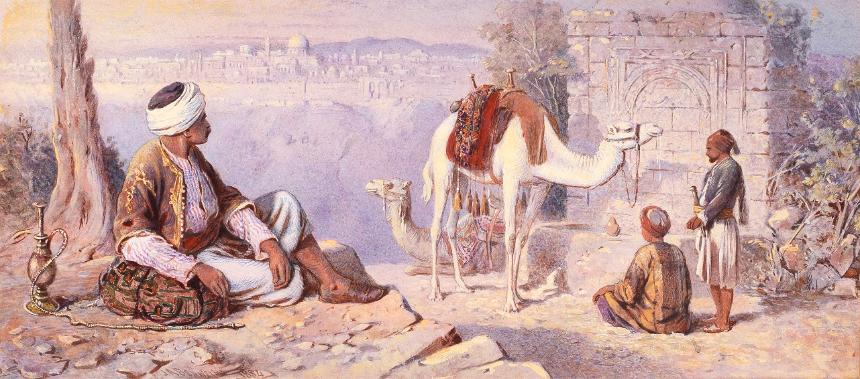
'Jerusalem from Bethany' 1884
Extract from 'The Examiner and London Review', 23 April 1870, 'Travellers Resting'
Extract from 'Liverpool Mercury' 18 June 1871, 'Arabs Halting'
Extract from 'The Bristol Mercury ' 16 June 1881, 'Mount Sinai'
2. Old auction catalogues
Old auction catalogues are a good source of information on the history of paintings as they are bought and sold over the years at various auction houses. They can be very useful for provenance purposes, and sometimes a previous owner can be established. For example, the painting ‘Temple of Isis on the Nile’ was sold by Christie, Manson & Woods at 8 King Street, London on Tuesday February 28th 1893 in a sale entitled ‘Water-colour drawings and modern pictures’ of John Rowland Gibson Esq., deceased, late of 10 Russell Square (Also Water-colour and Drawings from various private sources). In this case, Lots 1-71 were from the collection of John Rowland Gibson, and lots 83-120 were from ‘Another property’.Although we cannot establish the name of the owner in this instance, we do know that the previous owner also had a Constable in his/her collection!
Extract from 1893 auction catalogue shown below.
Modern Pictures and Drawings and Works by Old Masters' sale by Messrs Christie, Manson & Woods, King Street, St James's Square, London on Saturday 1 February 1908 - below.
3. Old exhibition catalogues
Old exhibition catalogues are also a useful source of information on artists’ works. Some have been digitised and are available online. For example, the catalogue for the London International Exhibition 1873, held in South Kensington, and the catalogue for the Sydney International Exhibition in 1879-80 (refer below).
Artists’ names and auction/exhibition catalogues can be searched for online on websites containing digital versions of old books and catalogues, such as HathiTrust.org. A good place to start is the WorldCat website to search library collections worldwide, including all editions and various formats of the documents. The website gives availability of publications in libraries and also online/digital format. The website has the option of just searching for publications that are available as e-books to view online (under ‘format’ on the left-hand side).
Actual hard copies of old auction and exhibition catalogues can be purchased on eBay and specialist websites such as The CatalogStar.com. More recent catalogues, from about the 1980s, are relatively easy to track down. If you have purchased an old painting, it is definitely worthwhile trying to find old auction or exhibition catalogues featuring the painting, maybe going back many decades. It all helps towards the provenance and it is fascinating to trace the history of your painting.
Extract from “Bristol Art Gallery: Catalogue with descriptive notes, of the permanent and seventh loan collection of pictures, and the collection of statuary “ compiled by Richard Quick, 1908. 'Halting by the Sphinx' J A Benwell, 1873. Lent by C Hayes Esq. "Joseph A Benwell was born in 1816, his father being a well-known Quaker. He was at one time in the office of Jacob Sturge, Clare Street, Bristol. He is noted for his Eastern scenes, and the drawing of camels.'
This may well be the painting of the same name (Halting by the Sphinx) and date (1873) that was sold in December 1907- refer to 'Art Prices Current' under item 4 below. Possibly it was a recent acquisition by the new owner. Also refer to the section on the Benezit Dictionary, below.
'Mecca Pilgrims passing the Sphinx' 1884
One of the first major Exhibitions that Benwell exhibited at was likely to have been in 1869 at the 'Society of British Artists' Annual Exhibition No. 46, 1869, Suffolk Street, Pall Mall East, London (see cover above). At that time, he had not long returned from his travels in Egypt, Sinai and the Holy Land, and is listed as residing at 5 Upper Gore, Kensington. He exhibited three works:
670 - 'The Land of Egypt- Pilgrims en route' £42, North Room, (p36)
766 - 'Departure from Cairo' £12 12s, North Room, (p 40)
1064 - 'Preparing to Encamp, Nubia' £31 10s, North-East Room, (p51)
At the 1875 Suffolk Street Exhibition of the Society of British Artists, Benwell exhibited alongside Mr (W P) Frith and Mr F Leighton (later Frederic Lord Leighton, who became President of the Royal Academy in 1878). Frith exhibited a portrait of his wife, and Leighton exhibited 'A Florentine Youth' and 'A Ruined Mosque near Damascus'. Refer to the art research page on this website for some information on Frith and Leighton.
Extract from 'The London Sketch-Book', v 1-2, 1874-75, page 14. Society of British Artists Exhibition, Suffolk Street.
London International Exhibition of 1874 : the fourth of a series held under the direction of Her Majesty's Commissioners for the Exhibition of 1851.
In the London International Exhibition of 1874, Benwell exhibited No. 831 'Temple of Dendera', which was for sale at 30 guineas. It is interesting that his wife, Marian Benwell, also had a painting in this exhibition No. 1302 'Travelling in the Desert', 12 guineas. It is known that she was also an artist, but I have been unable to find out much about her. She exhibited some Italian landscapes, but this particular painting must be of a Middle-Eastern scene. Both J A Benwell and his wife Marian Benwell also exhibited in the 1871 London International Exhibition and the 1873 London International Exhibition. In 1871 he exhibited No. 1841 'Bound for Mecca' (1871) and Marian exhibited No. 1837 'Ancona, with the Arch of Trajan'. . In the 1873 Exhibition he showed No. 1551 'Cafe Door, Cairo' and Marian showed No. 497 ‘Boulak, the Port of Cairo’. They married in 1854, so it seems quite possible that Marian accompanied her husband on at least one of his journeys to the Holy Land, Egypt and Middle East in the 1860s.
Extract from the Official Catalogue (Fine Arts Department) of the 1871 London International Exhibition.
Extract from page 17 of the Sydney International Exhibition (1879-80) catalogue shown below 'Desert Travelling, Valley of Sinai'.
120 - Approaching the Encampment, J A Benwell
4. Miscellaneous books and art price publications
Miscellaneous books and art price publications. A useful example is the series 'Art Prices Current', published by the London Offices of the Fine Art Trade Journal, which lists auction sale results for works of art sold during the year. Volume 1 covers the year 1907/08, and was published in 1908. Volumes 1-9, covering the period 1907/08 to 1915/16, have been digitised and are available online on The Internet Archive. Most of the listings are for Christie's sales, and later volumes include other auction houses.
Extracts are shown below, including Benwell's 'A Camel Caravan', sold in June 1908, and 'Halting by the Sphinx' (1873), sold in December 1907. The inclusion of measurements of the paintings, and the year, provide a useful cross-check for identification purposes.
For example, I had known about Benwell’s painting ‘Street Scene, Cairo’ for some time, but had never seen an image of it. I recently found an illustration and more detail about the painting in the Lyle Official Arts Review of 1983, when it was up for sale by auction by Sotheby, King and Chasemore (probably in 1982). Another is 'Egypt: Music outside a Temple' 1867, from the Lyle Official Arts Review of 1984, when it was sold by Christie's.
'Egypt: Music outside a Temple' 1867,
Mayer International Auction Records are another useful source of information, although not many illustrations are included. Again, some of these publications have been digitised and are available on archive.org. See below.
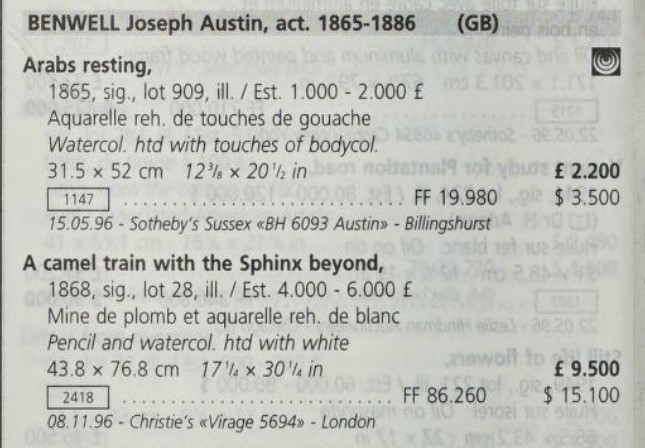
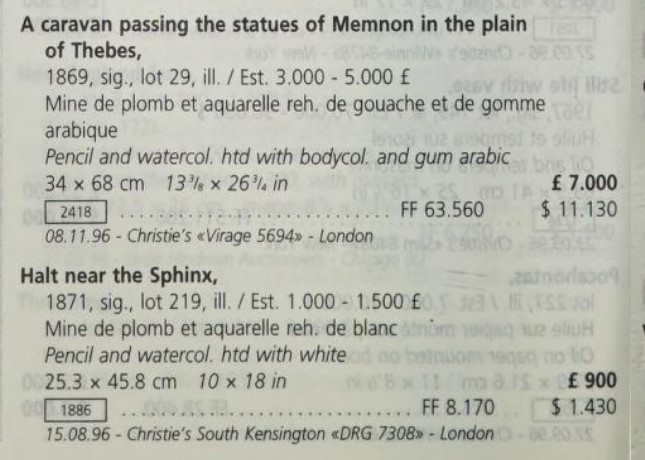
From Mayer International Auction Records 1997- includes details of Benwell's 'Arabs Resting', 'A Camel Train with the Sphinx beyond', A Caravan passing the Statues of Memnon in the Plain of Thebes', and 'Halt near the Sphinx'.
This extract gives useful information about several of Benwell's paintings, including 'Halt near the Sphinx', 'The Temple of Isis', 'Characters from the Orient- Studies of Arabs' and 'In the Land of Egypt'. The entry also notes that Bristol Museum has 'Halt near the Sphinx' in its collection (as of 1924). I contacted the museum, but they were unable to say whether or not they still had the painting, or what happened to it.
Other useful publications include books such as 'Works Exhibited at the Royal Society of British Artists, 1824-1893 and the New English Art Club, 1888-1917’ (J Johnson, Antique Collectors’ Club, 1975).
It lists some of Benwell’s Orientalist paintings that were exhibited at the Royal Society of British Artists between 1866 and 1886. Shown below is an extract from this publication. To date, I am not aware that it has been digitised for the public domain, and I went to the Tate Reading Rooms to see a copy.
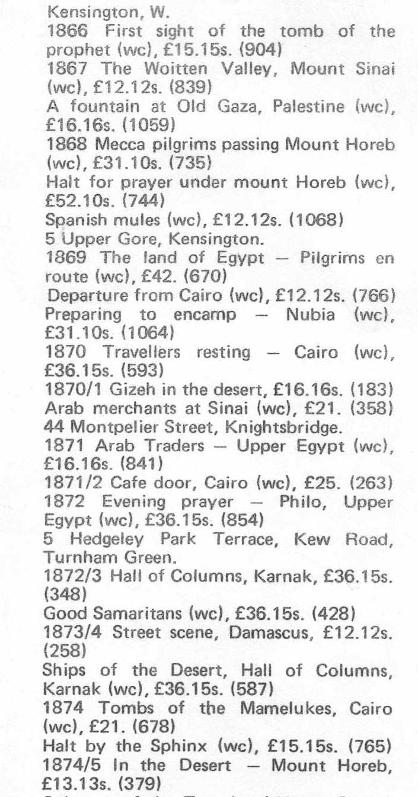
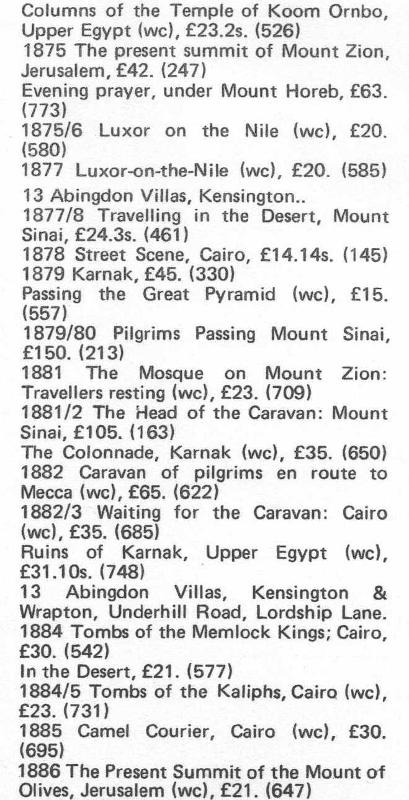
Titles of paintings can change! Some of those listed may in fact refer to paintings that are known by another name today. In fact, so far I have not been able to match many of these with current internet records. Either there have been a few changes in title, or there are many paintings out there that have not been recorded or listed during the past few decades. This is something to be aware of in your research.
An example of changing titles of paintings over the years is that of Benwell’s ‘A Rest before the City Gates’ (Lot 180 Christie’s sale 1 Oct 2008). Art auction catalogues in the relatively recent past list it as 'Arabs resting outside a town' (Lot 173 Christie's sale 29 Nov 1984 and Lot 134, 13 Dec 1983), and 'Arabs resting on the outskirts of a City' (Lot 451, Sotheby's sale 6 Nov 1985). The image is the same as the more recent acquisition, although the precise measurements vary a little; this is because, as related above, the painting was re-framed and given a new mount in the 1980s, which covered the signature and most of the date and made the image appear fractionally smaller. In this case it is clear that it is the same painting. Of course, it may not be wise to presume in the same way for other paintings, particularly when an artist is known to have painted similar or identical scenes. If the title can change over the course of a few decades in recent years (when better records are kept), then it is quite likely that this also occurred over longer periods of time in the past. This painting may have been known by a completely different title in the nineteenth century. Also refer to 'The Great Sphinx of Giza' below, another example of changing titles.
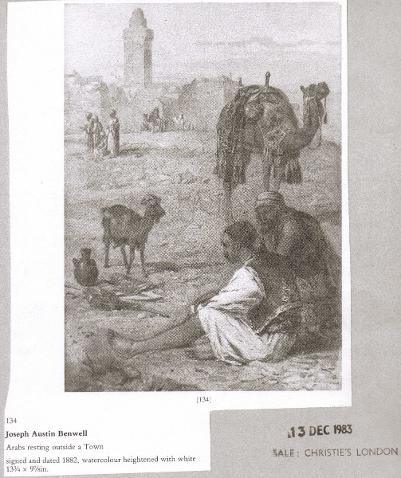
'Arabs resting outside a Town'
Christie's 13 December 1983
13 3/4 x 9 7/8 in.
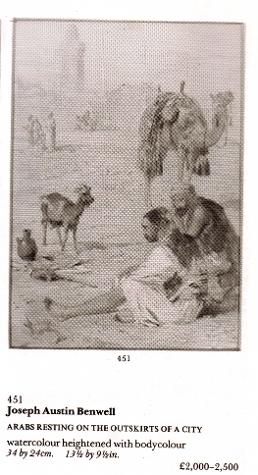
'Arabs resting on the outskirts of a City'
Sotheby's 6 November 1985
13 1/2 x 9 1/2 in. (34x24cm)

'A rest before the City gates'
Christie's 1 October 2008, 13 3/8 x 9½ in. (24.2 x 34 cm.)3/8 x 9½ in. (24.2 x 34 cm.)
3/8 x 9½13 3/8 x 9½ in. (24.2 x 34 cm.) in. (24.2 x 34 cm.)
Same painting - different titles
'
The same painting was sold on 5 July 1978 by Bonhams; Lot 44, dated 1870, 14 x 28 ins ((35.5 x 71cm), but titled 'Caravan, Smyrna' (see black and white image below). The same painting was sold by auction at Millon & Associes of Paris in December 2019, now titled 'L'arrivée de la caravane et du palanquin', or 'The arrival of the caravan and the palanquin'. 36 x 70.5 cm. Date stated as 1879, but this is more likely to be 1870, depending on the correct transcription of the inscribed date.
The painting is another example of a woman in a howdah or hawdaj (Arabic, see above).
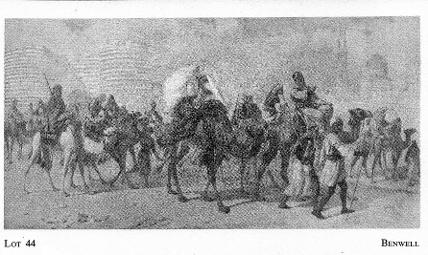
These days more interest is shown in paintings which depict a known site or location, as this provides a historical record of the place at that date in time- in this case 150 years ago (1870).
Smyrna was an ancient city on the Aegean coast, and came to prominence as an important trade route, attracting many camel caravans. The modern city located there is now known as Izmir, and is in Turkey. A fire broke out in the Greek and Armenian quarters of the city in 1922, known as the Great Fire of Smyrna. Many historic buildings were destroyed.
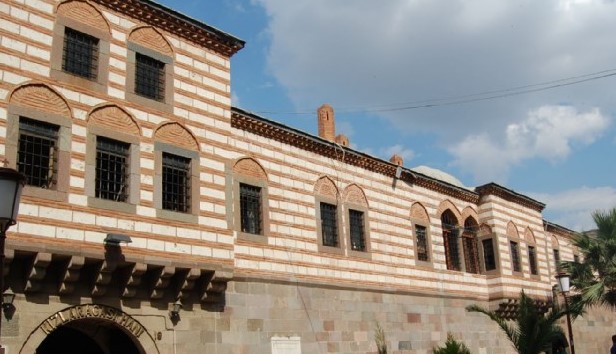
Also refer to 'The Great Sphinx of Giza' below, another example of 'changing titles'.
I wonder if this painting depicts the Kızlarağası Han (part shown left, modern day), which is Izmir’s largest and most impressive caravanserai (traveller’s roadside inn, or han in Turkish). This was built in the Ottoman style in 1744 and located next to the Hisar Cami (Izmir’s largest mosque).
In years gone by, many camel caravans would have made their way to this site. Like most historic structures in Turkey, the Han sustained damage in the past from natural disasters, but was renovated every time, so the shape of the buildings today may not be exactly the same, but the characteristic stripes are still a feature. Could this painting therefore possibly depict the caravanserai of Izmir's Kızlarağası Han?
"Star in the East"
The extract below is taken from the book 'Diary Dottings in Palestine and Egypt' by James Judd, published in 1887 (p.32). It refers to a painting by Benwell called "Star in the East". To date, I have not come across such a painting in the records. The author gives a reasonable description of the painting, so it should be possible to identify should the painting re-emerge.
I am intrigued as to why James Judd referred to my 3xgt granduncle as "poor dear Benwell". Possibly it was because Benwell died in May 1886, not long before Judd set off on his travels. On digging into the family tree, it is apparent that James Judd was married to Sarah. the sister of Benwell's wife Marian. So he was a brother-in-law by marriage. James Judd (1829-1901) was a printer and publisher (and later a JP) based in Upper Norwood, employing some 400-420 hands at the time of the 1881 census. Benwell provided engravings for Judd & Glass's book 'Counsels to Authors and Hints to Advertisers' 1856 (see the reference in 'Travel and Miscellaneous' section).
An early "package tour" to the Pyramids with Mr Cook himself in 1886-87
The book is dedicated to J M Cook Esquire, who was the son of Thomas Cook (the pioneer of tourism with his early travel company). John Mason Cook took over the company in 1878, greatly expanded it. The company had offices and many staff in Egypt. He accompanied Judd on this trip October 1886-January 1887. "To the world you are known as the King of Tourists, as one who has so perfected the facilities for travel, that the science, enterprise and labour required in their accomplishment are forgotten in the enjoyment of the perfection attained. By and by you will be recognised as the great benefactor of your generation.....besides all this, you are a warm personal friend...."
The Great Sphinx of Giza' 1886 (or, 'Resting caravan in front of the Sphinx of Giza'; or, 'Halt by the Sphynx, Egypt')
Signed and dated lower left- J A BENWELL. 1886, KENSINGTON. W.
Referenced in 'Art Prices Current, 1909-10, Vol III, A Record of Sale Prices at Christie's during the Season' , publ, London, Offices of the Fine Art Trade Journal, on December 13, 1909: 114. Benwell J A (1886) 'Halt by the Sphynx, Egypt' 13 x 26 (Sampson). This may be the original title of the painting.
Sold on 15 September 2010 by Bonhams as 'The Great Sphinx of Giza', and previously by Sotheby's on 3 December 2002 as 'The Sphynx'.
Sold on 10 May 2015 by Kunstauktionshaus, Schloss Ahlden, Germany as 'Rastende Karavane vor der Sphinx von Gizeh' (or 'Caravan at rest with the Great Sphinx of Giza beyond')
Note that the Sphinx is shown buried in sand up to the shoulders. Partial excavations were made in the 1870s. The entire Sphinx was excavated in 1925-1936.
The painting must have been completed in Benwell's studio at 13 Abingdon Villas, Kensington, based on sketches and previous studies/artworks of this subject. not long before his death on 13 May 1886. It is likely to be one of his last works, possibly his last. I have counted twelve camels in this painting.
James Judd in his book 'Diary Dottings in Palestine and Egypt' 1887 (p.73, see above) refers to this painting and other artists' depiction of the Sphinx. He states "After resting a while. went on to the Sphinx, the colossal head with which we are so familiar. It has recently been cleared of the sand, so we have now, therefore, the whole body revealed. From one point only is it like the Sphinx with which poor Benwell (note- see ref above to 'poor dear Benwell') and other artists have made us acquainted." Judd then goes on to describe the Sphinx and details its measurements. Note that Benwell would have executed his painting based on sketches made during his earlier travels, probably in the 1860s.
Signature on 'Halt by the Sphynx' /The Great Sphinx of Giza
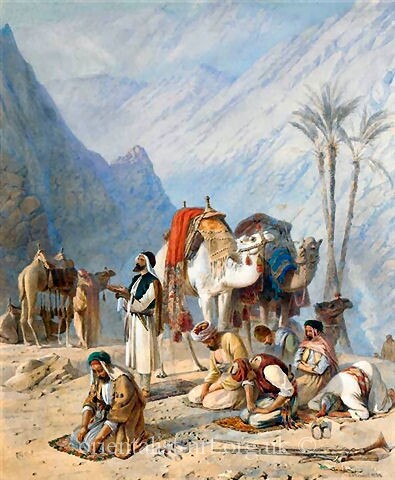
'Halt for Prayer under Mount Horeb' 1865
'Halt for Prayer under Mount Horeb' was exhibited at the Royal Academy 1865, No. 627, South Room (The Exhibition of the Royal Academy of Arts, The Ninety-Seventh, 1865).
Extract from the Glasgow Herald 13th April 1869, The Fine Art Institute Exhibition: “J A Benwell has a piece of rich warm colour in the ‘Halt for Prayer under Mount Horeb’, No. 635. The impression of dazzling sunshine and sweltering heat, appropriate to an Eastern desert, is effectively conveyed; nor has the artist spared his pains in delineating the worshipping Arabs, and the drowsy-looking camels, whose bright coloured housings help to enliven the scene. As a whole, the drawing is forcibly suggestive of Eastern scenery and of an interesting phase of Oriental life”

'Eastern Merchants'
'The Wandering Musicians' 1867

'The Evening Halt'
'The Evening Halt'
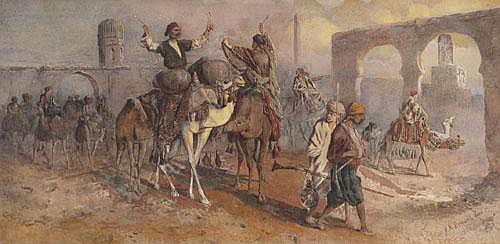
'Arabian Market'
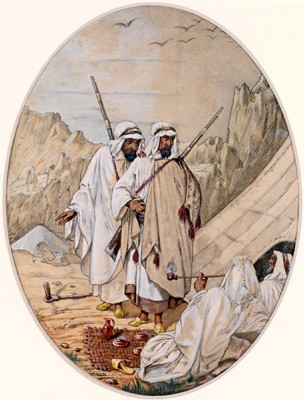
'Resting Arabs in the desert mountains'
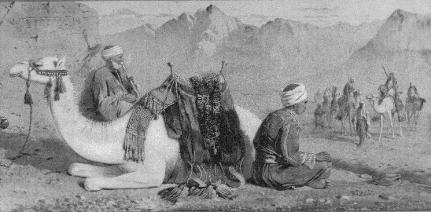
'Halt in the Written Valley, Desert of Sinai' 1883
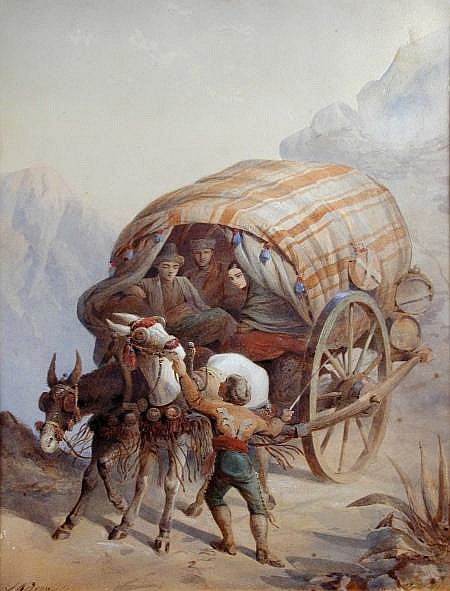
'A Mule Cart in the Alps'
note: the figures appear Eastern in appearance and in the author's opinion the scene is more likely to be set in the Himalayas, where other of JAB's illustrations were set.
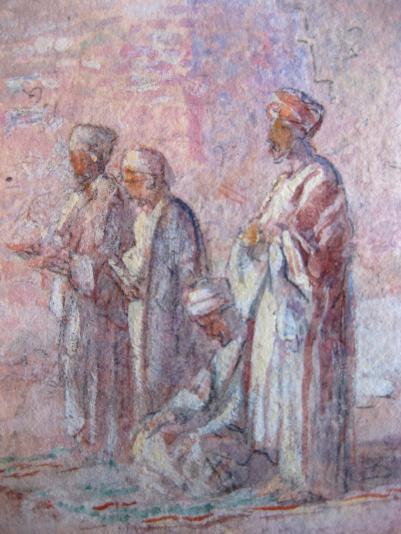
Magnified detail from background of ' A Rest before the City Gates' (above), showing Arabs at prayer
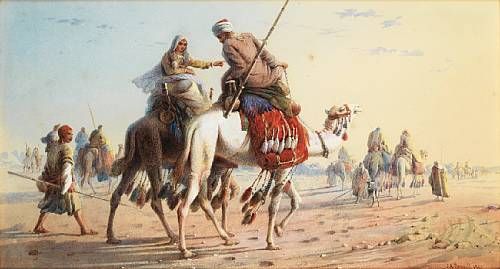
'Bedouin Caravan in the Desert' 1867
This same painting is referred to as 'Caravan in the Desert', dated 1864 in a couple of reference sites. The 1864 date may be incorrect, based on a 2010 auction. The date in lower right hand corner appears to be 1867.
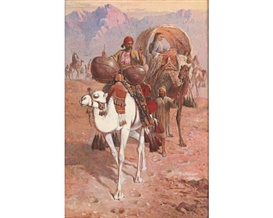
The Head of the Caravan, Mount Sinai' 1882
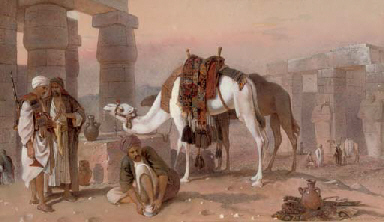
Egyptians and their camels resting by a Temple' 1877
Christie’s Lot 108 3 October 2006 or ‘Arabs watering their camels by ruins’ 1877, Christie's Lot 160 3 November 1977, 11 x 19in (27 x 4.8cm)
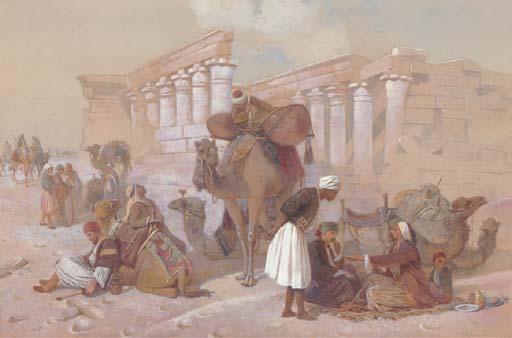
'Arabs with their camels by temple ruins' 1873

Magnified detail from background of ''A Rest before the City Gates' (above) - the famous 'White Camel' makes a more elusive appearance
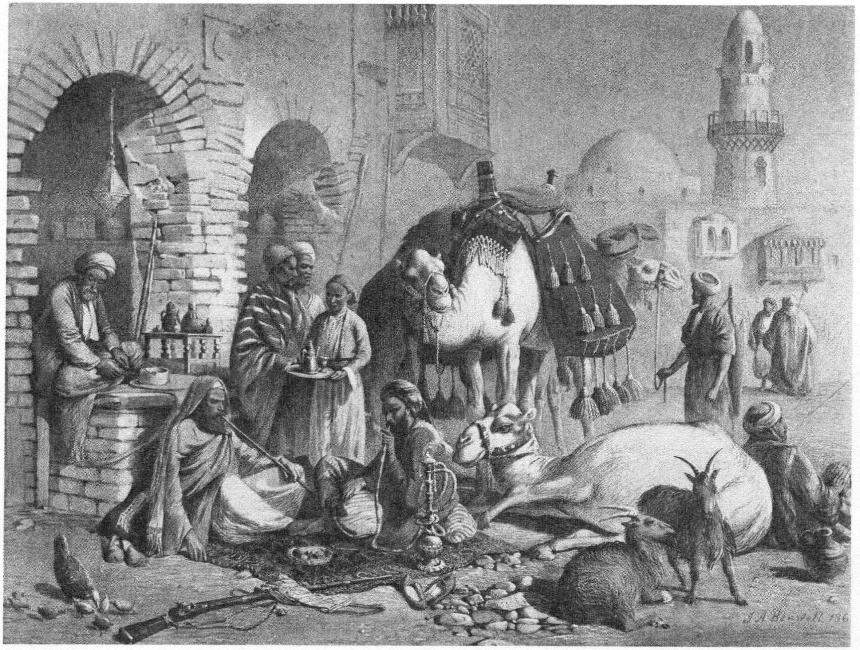
'Coffee Shop in the Via Dolorosa, Jerusalem' 1865
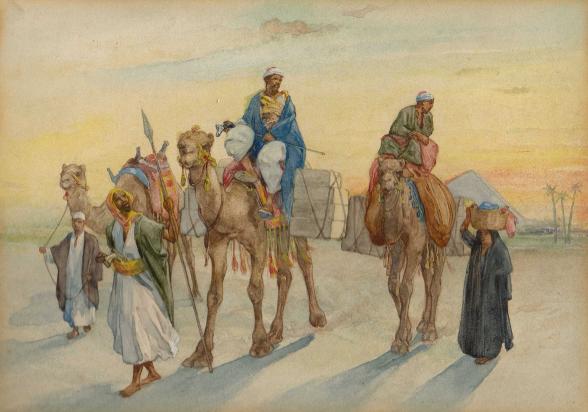
'Desert Travellers'
Attributed to Joseph Austin Benwell, inscribed on the back
'Edward Julius Detmold'. Refer Desert Travellers- An Enigma?
'The Board Game' 1870
The Building on the right Is the Mosque and Madrasa of Prince Iytamish al-Bugasi, which was built in 1383 AD. Bab al-wazir Street. Old Cairo, Egypt .1870
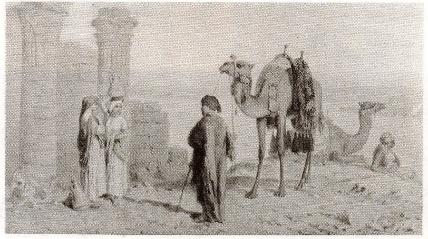
'An Arab Trader talking to women on the banks of the Nile', 1881
10 x18.25in (25.5 x 46.5cm).
Lot 126 Sotheby Parke Bernet, London 16 October 1981
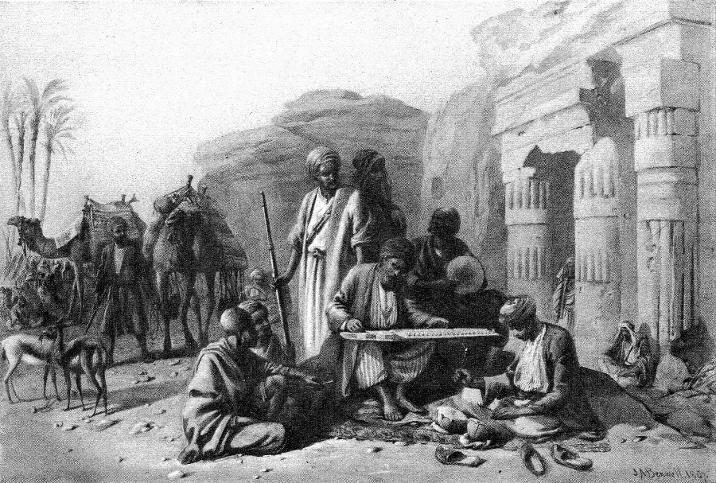
'Egypt: music outside a Temple' 1867, or
'The wandering Musicians'
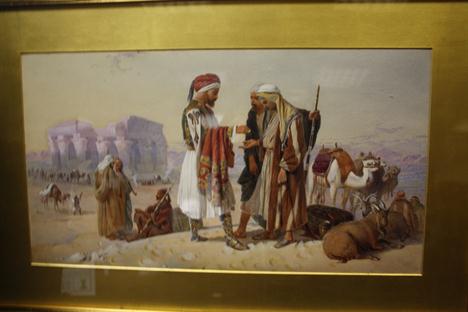
'Egyptian Tradesmen standing before ruins'
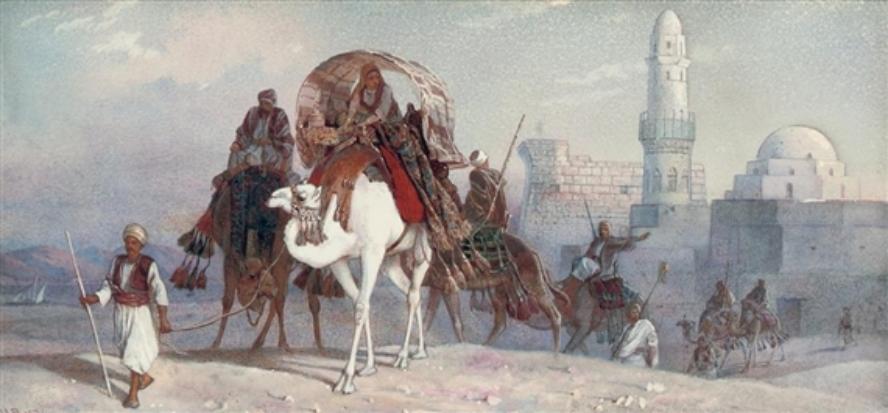
'The Desert Caravan, Egypt' 1874, or
' A Camel Train leaving Luxor'
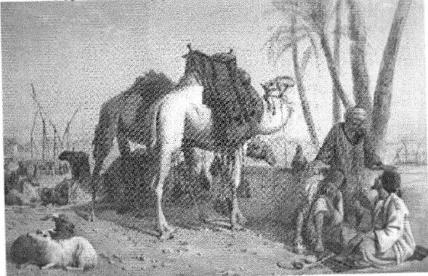
'Bedouins resting by the Nile'

'Caravan passing by the Great Pyramids'
Egypt - Following in Benwell's Footsteps in 2024
Joseph Austin Benwell's art - Victorian Religious Publications
Joseph Austin Benwell's art - Scenes from India
Joseph Austin Benwell's art - miscellaneous and travel
Joseph Austin Benwell, William James Müller and ‘Prayers in the Desert’
Art Research - other Bristol artists and miscellaneous Including George Cumberland 1754-1848 (web page in development)
Material researched and written by Dee Murray. Website compiled by Dee Murray. All rights reserved.
All images on this website are either scanned or photographed from the author’s own resources, or are in the public domain in digital format via websites such as HathiTrust, Openlibrary.org, the Internet Archive (archive.org) or Google Books.